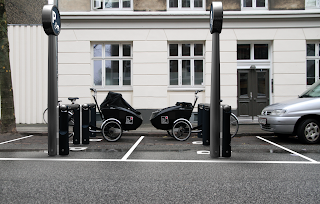

In early 2013, Mikael Colville-Andersen developed a design for on-street cargo bike parking that creates space and accessibility for citizens that use cargo bikes on a daily basis.
After this otherwise great prototype for on-street cargo bike parking was removed due to political decisions in Copenhagen, Mikael started thinking about how to design a solution that would improve parking conditions.
After almost three years of working with the EU project Cyclelogistics, cargo bikes have become a main focus of Mikael's work. He has two cargo bikes himself and parking is a primary challenge.
When you use a cargo bike everyday, you want to have it handy. In many cities, like Copenhagen or Frederiksberg, you find yourself pushing it into the back courtyard because of a lack of secure parking on the street. Cargo bikes are objets de désir for thieves and, unlike regular bicycles, the theft of them is often organised. Most Danish brands are good quality and keep a fair chunk of their market price when sold used. People who do park their cargo bikes out in front of the buildings are forced to lock them to signs, drainpipes and other bits and pieces of urbanness. They often take up a lot of space - easily the space of two regular bikes. So the idea was to design an elegant, functional parking solution for cargo bikes. Prioritising cargo bike parking and giving people extra security.
In situ visualisation
Surprisingly, cargo bike parking solutions have not been a priority, despite the fact that in Greater Copenhagen there are 40,000 of them. The aforementioned pink car was a step in the right direction and at a shopping centre, Fields, south of the city, dedicated cargo bike parking is in place. But that ain't much. Certainly not with the growth of cargo bikes in cities all over Europe and beyond.
The challenge Mikael gave himself included these keywords:Functional. Elegant. Unique. Secure. Sense of security. Flexible. Modular.
The rack should look good on the street or outside shops/buildings. It should be a deterrent for thieves and offer the user both security and sense of security when parking on street. Mikael wanted a unique design - most cargo bike solutions involve merely placing a metal railing next to them to which you can lock your bike. Making it flexible meant that it a majority of cargo bike brands should be able to use it. There are over 30 brands in Denmark alone, let alone some foreign ones on the market like Bakfiets and Johnny Loco, so it was important to make sure that as many of them as possible could use it. The primary user was thought to be residents in densely-populated neighbourhoods who could use the MCA/13 on the street outside where they live, instead of having to muscle the bike into the backyard. Modular was important because the urban landscape is never uniform. After doing the initial drawings and design, Mikael had visualisations made. You simply roll the cargo bike into the space and lower the bar between the seat and the cargo bay. You lock the bar into place with a lock (at left) and you can supplement it with a lock through the bar itself. Many people who park their bikes on street carry two heavy-duty locks. As all bikes in Copenhagen have a wheel lock, this is also invariably locked, as well.Mikael and his team hit the streets last year and measured every single cargo bike brand on the market. The height of the bar was the most important detail. It had to be placed so that a thief couldn't just take off the back wheel and push it forward under the bar. The majority of cargo bikes have a step-through frame but a couple of them have a low crossbar. The Sorte Jernhest (Black Iron Horse) and Bellabike. The design fits all models up to the height of the crossbars on these two brands.
Another in situ visualisation. Providing parking for five citizens in the space of two car parking spots. Note: The MCA/13 will be lower than shown here. The design can be fastened into the asphalt or, if need be, a base plate can be fixed to the ground.
The Next Generation


There are plans to develop a more digital version to complement the analogue one. This will feature a subscription service from the municipality or, perhaps, a supermarket chain. A user can use an app - like most bike share systems around the world - and the internal lock will take care of the rest.











